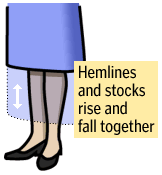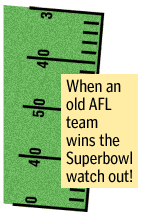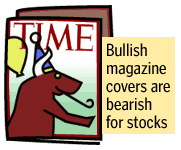NEW YORK (CNN/Money) -
So far 2004's been good for the market. Now if stocks can just keep their head above water through Thursday, we can all be confident that Wall Street is going to have another year in the black.
Or so says the theory that the first five trading days of the year act, in the words of the Stock Trader's Almanac, as an "early warning system." Since 1950, stocks' performance in the first five days of January predicted the direction for the rest of the year 72 percent of time. Not perfect, but it ain't bad.
Now if the Packers can just take the Super Bowl, if the whole month of January can be up and if hemlines (wherever they may be right now) can go higher, all will be well with the market. One of the few constants on Wall Street is that somewhere somebody is pointing to some quirky indicator and thinking it says something about where stocks are headed.
As April goes...
Watching how the first five trading days go is really just a truncated version of something called the January barometer. Look at the S&P 500 since 1950, and you'll see that January has predicted the markets' performance for the year all but eleven times. (Last year was one of the misses.) Stunning right? Hang on.
"Part of the reason the January barometer works so well is a statistical faux pas," said John Bollinger, head of Bollinger Capital. "It uses January to predict the year, not the following 11 months."
Take 1987, a year that the January indicator "worked." The S&P tacked on 13.2 percent in January, and closed the year up 2 percent. But from the end of January to the end of December, it fell 9.9 percent.
Still, January has a decent record of predicting stocks' direction for the following 11 months of the year, failing just 14 of the last 50 times. But April's not far behind, failing only 16 out of 50 times. How come nobody talks about the April barometer?
Hubba hubba for hemlines
When people talk about traders' love for statistical nonsense, the hemline theory -- when hemlines go up, so do stocks -- invariably comes up. What could be sillier than thinking the length of skirts has anything to do with stocks? Sounds more like an excuse traders in Wall Street's mostly boys' club came up with to look at women's legs.

But Bollinger thinks that there may really be something to the hemline indicator -- or at least that there was. "I think hemlines were a good indicator in their day," he said. "It talks to euphoria and depression and how people behave in a mass sense."
Hemlines rising showed that people were loosening up and living high. When they fell, they spoke to a rise in the conservative mores which often translated into investing conservatism as well. In a similar vein, Leonard Lauder, the chairman of Estee Lauder, has said that lipstick sales are a good indicator of consumer behavior.
Sadly, hemlines' height doesn't say the same things that it used to, said Bollinger, and we have to find some other indicator to track mass psychology. Tongue-kissing pop stars, maybe?
Super silliness
Say the following in your best football announcer voice:
It was January 15, 1967, when Vince Lombardi's Green Bay Packers stormed the field to determine the course of the American stock market for the remainder of the year.

Ah, the Super Bowl indicator. When a team from the old American Football League (AFL) wins the championship it's going to be a down year, whereas if an old National Football League team wins, it's open field running for stocks. From 1967 to 1997 this indicator was right 27 of 30 times -- an amazing 90 percent success rate. But then it got the market wrong four times in a row, revealing itself, according to Legg Mason strategist Paul Macrae Montgomery, as the statistical anomaly that it is.
"I usually write up the Super Bowl indicator every year just to say it's nonsense," he said. "It's an example of data mining -- you can always find a series that fits. In the 1920s there used to be a Harvard-Yale indicator."
And in any case, nobody knows what to make of the Super Bowl indicator with all the expansion teams, like last year's winning Tampa Bay Buccaneers, that have been added. Maybe we can revise it, and say that it "worked" because the Oakland Raiders -- one of those old AFL teams -- lost.
Let's go, Packers!
God bless you Mrs. Whistleblower
Macrae Montgomery has a quirky indicator of his own -- he likes to look at the covers of the major weekly magazine covers.

When a bull graces the front of, say, Time or Newsweek, he thinks it shows that virtually all the good news in the market is so widely known that stocks have only one direction to go: down. A bearish cover, conversely, is a fine time to buy.
A recent example was in April of 1998, when Newsweek ran with a bull (in a wedding dress) on its cover trumpeting the story "Why We're Married to the Market." Not too much later, the Russian debt crisis hit and the market went into a sickening decline. Mercifully, in October the editors of Newsweek printed a black cover emblazoned with "The Crash of '99?" And so stocks recovered.
Although there have been no bulls or bears on the major news weeklies' covers, Montgomery thinks that Time's choice of Amazon founder Jeff Bezos as person of the year in December 1999 was a good sign that the end was nigh for the bull market. And he was heartened a year ago when Time's editors heaped praise on the women who helped uncover the messes at Enron and WorldCom when they declared 2002 the "Year of the Whistleblower."

This is an updated version of a story first published in January 2003.
|

